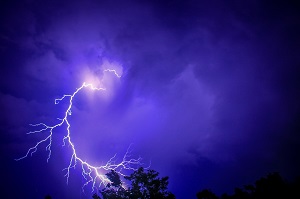![]() Lightning Strikes is a news and information topic monitored and covered by: Prepper Watch – Natural Disasters
Lightning Strikes is a news and information topic monitored and covered by: Prepper Watch – Natural Disasters
Introduction
Lightning strikes are one of the most overlooked yet dangerous natural phenomena that preppers must be ready to face. While not as far-reaching as hurricanes, earthquakes, or floods, lightning strikes can have devastating local impacts. A single strike can ignite wildfires, disrupt communication and power infrastructure, and even cause death or serious injury to those caught in the wrong place at the wrong time. According to the National Weather Service, lightning strikes the Earth about 8 million times a day — which means about 100 lightning bolts every second. In the U.S., an average of 49 people are killed by lightning each year, and hundreds more suffer from long-term injuries.
For preppers, lightning strikes present a dual threat: the immediate danger of being struck or injured and the cascading consequences of fires, power outages, and infrastructure damage. Preparing for lightning strikes requires a combination of personal safety measures, home and property protection strategies, and long-term survival planning. This guide will explore the comprehensive steps that preppers can take to mitigate the risks and prepare for the aftermath of lightning strikes.
Understanding Lightning Strikes
What Causes Lightning?
Lightning is a massive electrostatic discharge that occurs between electrically charged regions within clouds or between a cloud and the ground. The process begins when:
- Convection currents within thunderclouds separate charges, creating positive and negative electrical fields.
- When the charge difference becomes large enough, an electrical discharge occurs in the form of a lightning bolt.
- Lightning typically seeks the path of least resistance to the ground — which is why tall trees, poles, and buildings are common strike targets.
- A bolt of lightning can reach temperatures of up to 30,000 Kelvin (54,000°F) — hotter than the surface of the sun — and carry over 100 million volts of electricity.
Types of Lightning Strikes
- Cloud-to-ground (CG) lightning – The most dangerous type, as it strikes the earth and causes direct damage.
- Intra-cloud (IC) lightning – Stays within a single cloud and is less dangerous unless you’re flying.
- Cloud-to-cloud (CC) lightning – Moves between clouds, usually harmless to people but can disrupt electronics.
- Positive lightning – Less common but more dangerous, carrying a positive charge that can travel greater distances and cause more damage.
Why Lightning is a Threat to Preppers
Preppers often focus on large-scale disasters like EMPs, social unrest, or resource scarcity. However, lightning poses unique localized threats that can disrupt even the most well-prepared homesteads or bug-out locations:
- Wildfires – Lightning strikes cause over 44% of wildfires in the U.S. annually.
- Power Grid Damage – Direct hits on transformers or transmission lines can cause widespread blackouts.
- Communications Failure – A strike can fry communication towers and satellite connections.
- Water Supply Compromise – Lightning can damage well pumps or cause contamination if it hits nearby water sources.
- Personal Injury and Death – Lightning can kill directly through electrocution or cause severe burns, nerve damage, and respiratory failure.
Personal Safety Measures for Lightning Strikes
Prepping for personal safety during a lightning storm starts with understanding the right behaviors and precautions:

- Avoid open fields – If you’re caught in the open during a storm, crouch low with feet together to minimize ground contact.
- Stay away from tall objects – Trees, poles, and tall structures are natural lightning magnets.
- Avoid metal objects – Metal conducts electricity; stay away from fences, vehicles, and equipment.
- Find shelter – A car with a metal frame provides a safe enclosure, as the current will pass around the vehicle.

- Unplug electronics – Lightning can travel through wiring and destroy electronics.
- Stay away from windows – Lightning can blow out windows or send glass shards flying.
- Avoid plumbing – Water is an excellent conductor of electricity; avoid showers, faucets, and pipes during a storm.
- Use battery-powered devices – Rely on battery-operated radios and lights during storms.

- If caught in a car:
- Keep the windows closed.
- Avoid touching metal parts of the car.
- Pull over and wait for the storm to pass.
Home and Property Protection Against Lightning Strikes
Preppers often prioritize hardening their homesteads and bug-out locations against EMPs or fires. Lightning requires similar precautions:

- Lightning rods (air terminals) should be installed on the roof and high points of a structure.
- Bond rods to the ground with heavy-gauge copper wire.
- Add grounding rods at least 8 feet deep in conductive soil.

- Use whole-house surge protectors to defend against spikes in electrical current.
- Install surge protectors at breaker panels and at individual outlets for sensitive electronics.

- Keep roof and gutters clear of debris.
- Create a defensible zone around the home using gravel or non-combustible materials.
- Keep a fire extinguisher rated for electrical and structural fires in accessible locations.
Preparing for Infrastructure Failure
A direct lightning strike can cause localized power failures, damage to communications infrastructure, and disruptions in critical services.

- Install a solar power system with a battery bank and surge protection.
- Keep a portable generator ready and protected from weather.
- Use battery backups for medical equipment and essential devices.

- Protect well pumps and water storage systems with grounding and surge protection.
- Store emergency water in plastic or glass containers (metal can conduct electricity).

- Invest in HAM radios with backup batteries.
- Create a neighborhood emergency communication plan using mesh networks.
Protecting Livestock and Crops
Preppers with homesteads or farms face additional challenges when preparing for lightning:

- Provide low-profile shelter areas for livestock.
- Avoid fencing made from conductive materials like metal.
- Keep animals away from isolated trees or metal barns during storms.

- Use lightning rods on tall structures or trees.
- Use firebreaks and irrigated zones to limit wildfire spread.
- Keep irrigation and pump systems on surge-protected circuits.
Medical Preparedness for Lightning-Related Injuries
Lightning injuries require immediate medical response:

- Treat burns with clean, sterile gauze.
- Provide CPR if the victim is not breathing.
- Avoid direct contact with water or metal surfaces while assisting a victim.

- Victims may suffer from cardiac arrest or respiratory failure.
- Have a defibrillator (AED) and training on hand.
Long-Term Preparedness for Lightning-Induced Wildfires
- Create a firebreak around the property.
- Install fire-resistant roofing and siding.
- Stock up on fire suppression tools (shovels, fire extinguishers, water pumps).
- Have an evacuation plan and a bug-out route in case of spreading fires.
Conclusion
While lightning strikes may seem like a minor threat compared to hurricanes, earthquakes, or large-scale EMPs, they can have devastating local consequences. Preppers who take steps to protect themselves, their homes, and their communities from the direct and indirect impacts of lightning strikes will be better positioned to weather any storm — literally and figuratively. With the right preparation, you can minimize the risk of injury, infrastructure damage, and long-term disruption caused by this unpredictable force of nature.

